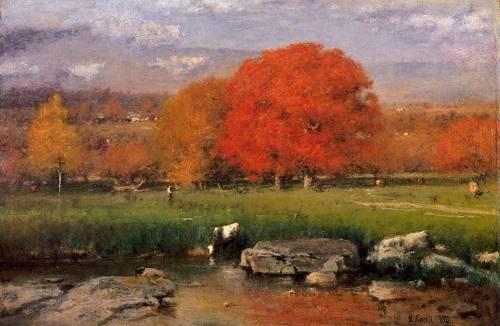Between the 1830s and the end of the First World War, American art came into its own. From the majestic Hudson River School paintings of Thomas Cole, John Kensett, and Albert Bierstadt to the gritty urban realism of Robert Henri and John Sloan, this presentation draws on the rich holdings of American paintings and sculptures in the collection of the Santa Barbara Museum of Art.
This selection of more than 50 paintings and eight sculptures highlights the maturation of a distinctly American idiom, one informed by international currents and engaged with capturing the fluxes of modern life. Masterpieces of landscape, genre, still-life, and portraiture, punctuated by a selection of sculptures, trace an evolution in style from an art driven by the mandates of westward expansion to one animated by experimentation. In both idealized and naturalistically rendered landscapes, in scenes of everyday life, or meticulously detailed images of everyday objects, the presentation also narrates an important chapter in American cultural history that witnessed the Civil War and its aftermath, the expansion of national boundaries and the closing of the western frontier, and the transformations wrought by the emergence of new technologies at the dawn of the 20th century.
This exhibition has been organized by the Santa Barbara Museum of Art.
From an excellent review in the Tampa Bay Times (some images added):
By the end of the 19th century, landscape paintings such as
George Inness' Morning, Catskill Valley and its flaming autumn trees inject a more overt spirituality.
Though sentimentality was a hallmark of many narrative or genre works of the time, they began also to address the reality of a growing urban underclass, a combination seen in
John George Brown's Boy Fishing and
Charles Blauvelt's portrait of an immigrant in Homeward Bound From New York.
John George Brown (British, active USA, 1831-1913), Pull for the Shore, n.d., Oil on canvas, 24 x 39 3/4 in., Santa Barbara Museum of Art. Gifts from the Estate of Mrs. Stanley McCormick, Norman Hirschl and the American Federation of Arts to the Preston Morton Collection by exchange 1971.18
In Brown's Pull for Shore, the men in a rowboat are presented in a more straightforward way, but avoiding the bleak realities that existed for poor working people...
"Cosmopolitanism in the Gilded Age" gives us the upside of all the new money at the turn of the century.
A Childe Hassam painting of The Manhattan Club and the swells walking around it, the
Interior of His Brother's House in Boston, by Walter Gay and
William Merritt Chase's The Lady in Pink (Portrait of the artist's wife), 1886 all excellent, aren't voyeuristic (they were painted at a time when those who would have seen them were social equals) or aspirational (ditto).
Combining works representing the "Closing of the Frontier" and those for the "Dawn of Mass Entertainment" into a single theme was a stretch for me in some instances, but I appreciated the unexpected juxtapositions. Frederic Remington's heroic bronze mountain man (1903) seems a long way from
Louis Eilshemius's disaffected patrons in the vaguely unsavory painting Plaza Theatre (1915), which calls to mind the Kit Kat Club in Cabaret. They're separated by just 12 years but we see the nostalgia and romance for a vanishing way of life and the strengths of individualism contrasted with a competing cynicism and sense of isolation.
The show ends with an homage to the Eight, a group of early 20th century artists who participated in a controversial exhibition in 1908...

Robert Henri (American, 1865-1929), Derricks on the North River, 1902, Oil on canvas, 26 x 32 in., Santa Barbara Museum of Art. Museum purchase for the Preston Morton Collection, with funds provided by the Chalifoux Fund 1977.45
As Henri wrote: "Paint should be as real as mud." His Derricks on the North River is a far cry from the Manhattan Club.
So is George Bellows' Steaming Streets, another dark urban landscape in which a trolley, spooked horse and onlookers combine. (Bellows wasn't in the Eight show but was an important part of Henri's circle.) Among other artists who weren't as tight with the Ashcans that were included in the Eight show was Maurice Prendergast; his Summer in the Park is a bright frolic composed of paint dashes that have no resemblance to mud.More from the exhibition:
Albert Bierstadt (German, active USA, 1830-1902), Mirror Lake, Yosemite Valley, 1864, Oil on canvas, 21 3/4 x 30 1/8 in., Santa Barbara Museum of Art. Gift of Mrs. Sterling Morton for the Preston Morton Collection 1960.51
Thomas Cole, The Meeting of the Waters, 1847, oil on canvas.
51 x 75 3/4"
Gift of Suzette Morton Davidson to the Preston Morton Collection
1979.19
John Frederick Kensett
USA, 1816-1872
View of the Beach At Beverly, Massachusetts, 1860
Oil on canvas
14 1/4 x 24 1/4"
Gift of Mrs. Sterling Morton to the Preston Morton Collection
1960.68
John Sloan
USA, 1871-1951
City from the Palisades, 1908
Oil on canvas
26 1/8 x 32 1/8"
Gift of Mrs. Sterling Morton to the Preston Morton Collection
1960.82












